Challenger GT goes, where others spin their tires
By John Gilbert
What’s wrong with this picture, as they say? It’s a photo of a beautiful new Dodge Challenger parked along a North Shore cove in Two Harbors, Minnesota, overlooking an icy Lake Superior, and sitting on a snowy, icy parking area.
Everyone know that the resurrection of the “Big Three” ponycars — the Ford Mustang, Chevrolet Camaro, and Dodge Challenger — is heartwarming and attractive, but those wonderful hot cars from the late 1960s through 1970 had one thing in common: front engine and rear drive. You either chose judiciously when to venture out between November and April, or, better, you parked them during the winter months.
With their wide tires and ready-to-race demeanor, those cars traditionally are not what yoiu think you should be driving in slippery conditions.
However, we now must make an exception. While the Mustang and Camaro have been modernized in styling updates in recent years, the Challenger has stayed truest to its 1970-era roots. Until now. Dodge made the most publicity out of adding the SRT Hellcat powertrain, and the over-the-top 808 horsepower Demon model.
Flying well below that outrageous 2018 power display, Challenger has added a GT model, which comes with a strong 3.6-liter V6 engine and winter-beating all-wheel drive. Think about that: all-wheel drive! The GT term, which traditionally stands for Grand Touring (or Gran Turismo).sounds like it should be hotter than its siblings, even the Hellcat and other huge-engined monsters, but in reality is possibly the best real-world model of all the ponycars.
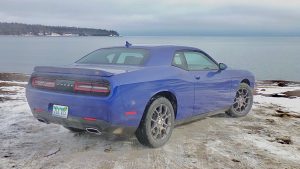
Challenger GT styling can be called “future-retro,” but for 2018, it houses a lot of technical advances.
The Challenger GT I recently test-drove was painted a stunning “IndiGo” blue, and otherwise, except for black alloy wheels and a tastefully small “GT” on its flanks, doesn’t jump out as a high performer. But take it up an icy avenue in Duluth, or drive off the street into the ice-covered parking area near Two Harbors, and when you want to go, just shift the 8-speed TorqueFlite transmission into “D” and step on the gas.
The familiar 3.6-liter V6 is perfectly tuned to operate the car, and it sends its 305 horsepower and 262 foot-pounds of torque down through its four specially-selected Michelin Primacy MXM4 tires, which we probably can call “high-performance/all-season” tires.
At its introduction, I was able to drive a Challenger GT on an icy test facility in Maine late last winter, and I got a real eye-opening experience at the FCA proving grounds at Auburn Hills, Michigan, where I drove an assortment of high-powered Challengers with their Hemi V8s up to over 800 supercharged horsepower. To my amazement, I found that on a specific part of that track, there is a serpentine stretch where the track gives you about a hundred-yard straight stretch, then a 180-degree switchback, back and forth for about six such turns.
I came away convinced that the precise steering and handling of the Challenger GT made the V6 model with AWD possibly the best-handling Challenger of all — and, in fact, maybe the best-handling car of any name ever made by Dodge.
With that in mind, I kept in the back of my mind that away from the controlled test-track arrangement, I couldn’t wait until I got my paws on the Challenger GT in a Northern Minnesota winter setting. It finally happened.
Right on cue, we had a nice little snowstorm punctuating the cold, which made for some treacherous driving. Getting through that early-January week was a snap for the Challenger GT.
To start with, you hit the key fob from the warmth of yiur kitchen and start up the refined, dual-overhead -cam V6. Let it run for a few minutes to get the oil circulating, and to get such things as the heated seats and heated steering wheel in proper mood to make even 0-degrees feel comfortable. It is one of the wonders of humanity that no matter how cold it is outside, hypothermia-threatening, if your butt and your hands are pleasantly warm, the rest of your body is comfortable until the full force of the heater gets up to speed.
The biggest problem I had, in fact, was to get the Challenger’s thick layer of road-salt glop washed away, and then, after a warm-up to the mid-20s, to try to maneuver the just-washed Challenger around the slimy streets. It didn’t work, no matter how good-handling the car was.
I did get some curious looks from other drivers in their AWD SUVs and pedestrians when I would turn a cornrer in downtowon Duluth and zip up an icy avenue without any problem.
The best thing about the appearance of the Challenger GT is that it does not appear to sit up high, the way most AWD vehicle do. It looks as low and sleek as the other Challengers, which is a good thing.
For a base price of $33,495 and a sticker as-tested fee of $38,965, the GT offers all the possible contemporary technology available. That includes standard electronic stability control, traction control, hill-start assist, electric power steering, high-performance brakes, an active transfer case with front-axle disconnect, and a load of interior features. Those include Uconnect capable of handling Apple or Android connectivity, various plug-ins, and such driver features as leather-wrapped steering wheel, and paddle shifters on the steering wheel.
Options on the test car include the technology group, with automatic high-beams, adaptine cruise, and forward collision warning; driver convenience group, with high intensity discharges headlights, blind spot and rear cross-path detection, and the remote start system; the GT package, including leather steering wheel, and an audio upgrade to nine speakers and 506 watts; and a navigation system with the 8.4-inch screen, as well as Sirius satellite radio.
Not only is the Challenger GT equipped with all those real-world assets, but it has that fantastic lilne-tracing steering and handling, and along with its comfortably supportive bucket seats, it actually has a roomy enough rear seat to house actual adult humans.
That makes it perfect, in case one of your neighbors finds himself or herself venturing out with a Mustang, Camaro, or “normal” Challenger and getting caught in a winter storm. You could stop and give them a ride home, and you wouldn’t have to waste any words boasting about the winter-beating capabilities of your prized, bargain-priced ponycar.


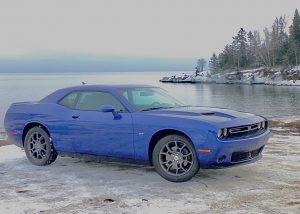
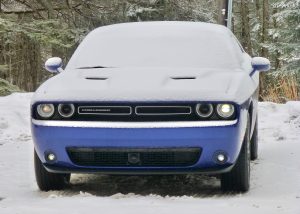
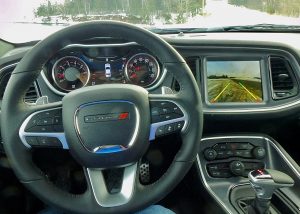
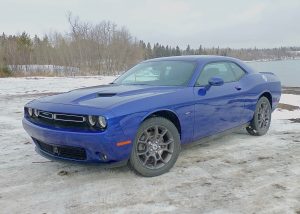
 John Gilbert is a lifetime Minnesotan and career journalist, specializing in cars and sports during and since spending 30 years at the Minneapolis Tribune, now the Star Tribune. More recently, he has continued translating the high-tech world of autos and sharing his passionate insights as a freelance writer/photographer/broadcaster. A member of the prestigious North American Car and Truck of the Year jury since 1993. John can be heard Monday-Friday from 9-11am on 610 KDAL(www.kdal610.com) on the "John Gilbert Show," and writes a column in the Duluth Reader.
John Gilbert is a lifetime Minnesotan and career journalist, specializing in cars and sports during and since spending 30 years at the Minneapolis Tribune, now the Star Tribune. More recently, he has continued translating the high-tech world of autos and sharing his passionate insights as a freelance writer/photographer/broadcaster. A member of the prestigious North American Car and Truck of the Year jury since 1993. John can be heard Monday-Friday from 9-11am on 610 KDAL(www.kdal610.com) on the "John Gilbert Show," and writes a column in the Duluth Reader.